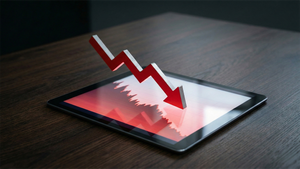
Precious metals gold and silver experienced a notable intraday correction on October 17, 2025, pulling back from their recently achieved record highs. This "intraday breather" saw significant declines in spot prices, with gold dropping 2.00% and silver plunging 1.7% after both metals touched unprecedented levels earlier in the day. While these sharp corrections might signal a pause, market analysts and investors largely view them as healthy profit-taking within a broader, deeply entrenched bullish trend for both commodities.
The current market dynamic presents a fascinating paradox: a short-term price retreat against a backdrop of overwhelming long-term optimism. Global uncertainties, persistent inflationary pressures, expectations of monetary easing by the U.S. Federal Reserve, and robust demand from central banks and industrial sectors are all contributing to a "flight to safety" narrative that continues to propel precious metals upwards. This correction, therefore, is not seen as a reversal, but rather a re-calibration, offering new entry points for investors keen on riding the ongoing precious metals bull market.
Precious Metals Experience Sharp Intraday Pullback Amidst Historic Rally
The financial markets on Friday, October 17, 2025, witnessed a significant intraday correction in the prices of both gold and silver, marking a temporary pause in their monumental ascent. Spot gold (XAU=), which had soared to an all-time intraday high of $4,391.69 per ounce, subsequently retreated by 2.00% to settle at $4236.57. Silver (XAG=) experienced an even more dramatic fluctuation, initially hitting a record high of $54.47 per ounce before falling 1.7% to $53.32. This sharp correction also resonated in the Multi Commodity Exchange (MCX) Gold December contract, which had reached an unprecedented ₹1,32,294 per 10 grams before showing signs of profit-booking.
The timeline leading up to this moment has been characterized by an extraordinary rally throughout October 2025, with both metals consistently breaching historical resistance levels. Gold had comfortably surpassed the $4,300 per ounce mark, while silver had dramatically exceeded its 1980 and 2011 peaks. This sustained upward momentum, however, had led to both metals entering technically overbought conditions. The intraday corrections on October 17th are largely attributed to this technical overheating, prompting short-term traders to lock in profits. Silver, in particular, displayed extreme intraday volatility, including a 6% correction at one point, indicative of low liquidity and potential short-squeeze dynamics.
Key players and stakeholders involved in these movements include large institutional investors, central banks, and speculative traders. Central banks, in their ongoing de-dollarization efforts and diversification strategies, have been consistent buyers, providing a strong underlying bid. Meanwhile, retail and institutional investors have been flocking to gold and silver-backed exchange-traded funds (ETFs), further bolstering demand. The initial market reaction to the correction, while causing some immediate jitters, has largely been one of understanding; analysts quickly pointed to the technical nature of the pullback, reinforcing the narrative that this was a healthy consolidation rather than a fundamental shift in market sentiment. The prevailing advice from experts remains to "buy on dips," signaling confidence in the continued upward trajectory of precious metals.
Mining Giants and ETFs Navigate Volatility Amidst Bullish Tide
The extraordinary rally in gold and silver prices throughout 2025, culminating in record highs in October, has created a largely favorable environment for public companies operating within the precious metals sector, though the recent intraday correction introduced a dose of volatility. Mining companies, in particular, have seen their profitability and cash flows significantly enhanced due to the operational leverage inherent in their business model; as selling prices soar, their relatively fixed production costs lead to exponentially higher profits.
Major gold producers such as Newmont Corp. (NYSE: NEM) and Barrick Gold (NYSE: GOLD) have been significant beneficiaries. Newmont, the world's largest gold producer, reported strong Q2 2025 results, exceeding expectations with robust production and controlled costs, leading to a near 80% surge in its share price year-to-date by mid-October 2025. Barrick Gold, another industry leader, alongside AngloGold Ashanti PLC (NYSE: AU) and Kinross Gold (NYSE: KGC), are consistently cited as top performers due to their scale, efficient cost control, and strategic initiatives. Smaller to mid-tier gold miners like Coeur Mining Inc. (NYSE: CDE), Hecla Mining Co. (NYSE: HL), and McEwen Inc. (NYSE: MUX) have also shown impressive 30-day returns.
In the silver sector, companies like First Majestic Silver Corp. (NYSE: AG), one of North America's prominent silver and gold producers, has seen its stock return 135.85% over the past year. Pan American Silver Corp. (NYSE: PAAS), a major silver producer in the Western Hemisphere, is poised for significant growth following its acquisition of a 44% stake in the high-grade Juanicipio mine. Other notable silver-focused entities include MAG Silver Corp. (NYSE: MAG), Endeavour Silver Corp. (NYSE: EXK), and Wheaton Precious Metals Corp. (NYSE: WPM), a leading silver streaming company that benefits from rising prices without direct mining operations. The recent intraday correction, while impacting stock prices temporarily, is largely perceived as a healthy rebalancing, with the underlying bullish sentiment continuing to support these companies.
Precious metals Exchange Traded Funds (ETFs) have also seen renewed investor interest, with significant inflows throughout 2025. Gold ETFs like iShares Gold Trust Micro (NYSEARCA: IAUM), GraniteShares Gold Shares (NYSEARCA: BAR), and SPDR Gold MiniShares Trust (NYSEARCA: GLDM) have delivered impressive one-year returns, often exceeding 59%. However, the recent correction highlighted a crucial point for silver ETFs, particularly in markets like India, where some silver ETFs plummeted between 6% and 8% on October 16, 2025, despite rising futures prices. This "disconnect" was attributed to a "normalization of inflated ETF valuations" and premium compression, underscoring the importance of monitoring valuation discrepancies in these instruments. While the overall outlook for precious metals ETFs remains positive due to sustained investor demand for safe-haven assets, short-term volatility and valuation nuances require careful consideration.
Broader Implications: A Shifting Global Financial Landscape
The recent movements in gold and silver prices, particularly their record-breaking rally followed by an intraday correction, underscore profound shifts in the broader financial landscape. The precious metals market is currently experiencing significant growth, with projections indicating a global market size potentially reaching over USD 545 billion by 2034. This expansion is not merely speculative but is deeply rooted in evolving global economic, geopolitical, and technological trends.
One of the most compelling trends is the dual demand for precious metals. While their traditional role as safe-haven assets continues to be paramount amidst global uncertainties—such as ongoing conflicts in Eastern Europe and the Middle East, renewed US-China trade tensions, and concerns over the U.S. economy—industrial demand is also surging. Silver, in particular, is witnessing robust consumption in green technologies like solar panels and electric vehicles, as well as in advanced electronics and emerging AI technologies, leading to a structural supply deficit for the fifth consecutive year. Gold also finds significant application in electronics and semiconductors, linking its demand to technological advancements.
The ripple effects of these price movements are far-reaching. Historically, rising gold prices often signal economic uncertainty, prompting investors to reallocate capital from riskier assets to gold, which can induce volatility in equity markets. Both gold and silver serve as potent hedges against inflation, with their appeal increasing as the value of fiat currencies erode. Furthermore, the aggressive accumulation of gold by central banks, especially from Asian and BRICS nations, highlights a strategic move towards de-dollarization and reserve diversification, a trend with significant geopolitical implications for global financial power dynamics. The gold/silver ratio, currently elevated, also suggests potential undervaluation of silver relative to gold, hinting at future rebalancing.
From a regulatory standpoint, the precious metals industry faces increasing scrutiny. Environmental regulations are becoming more stringent, addressing the significant ecological footprint of mining through mandates on impact assessments, waste management, and rehabilitation. Efforts to combat illicit activities are also intensifying, with AML (Anti-Money Laundering) and CTF (Counter-Terrorism Financing) regulations requiring rigorous due diligence and KYC (Know Your Customer) procedures for market participants. The London Bullion Market Association (LBMA) continues to enforce responsible sourcing guidelines, particularly concerning conflict minerals, ensuring greater transparency and ethical practices throughout the supply chain. Historically, sharp corrections in precious metals are not unprecedented, as seen during "Silver Thursday" in 1979-1980 or the 2010-2011 period, often serving as healthy "breathers" after prolonged rallies, allowing for market resets and new accumulation phases.
The Road Ahead: Sustained Bull Market with Strategic Nuances
The recent intraday correction in gold and silver, while sharp, is widely interpreted as a healthy recalibration within a powerful and enduring bull market. Looking ahead, both short-term and long-term possibilities for precious metals point towards continued strength, driven by a confluence of macroeconomic, geopolitical, and industrial factors.
In the short term (next 6-12 months), gold is projected to test the $4,400-$4,500 per ounce range by year-end 2025, with some analysts even eyeing $5,000 next year. This momentum is underpinned by expectations of further interest rate cuts by the U.S. Federal Reserve, which tend to weaken the dollar and reduce the opportunity cost of holding non-yielding assets like gold. Persistent geopolitical tensions and robust central bank purchases, particularly from emerging markets, will continue to fuel safe-haven demand. For silver, consolidation around $50-$55 is expected, with projections reaching $57.50 by mid-2026. Silver's short-term bullishness is further amplified by tightening supply and rapidly expanding industrial applications in green energy and electronics. While intermittent corrections of 10-20% are anticipated due to overbought conditions and profit-taking, these are largely seen as strategic buying opportunities.
The long-term outlook (beyond 12 months) for both metals is even more compelling. Gold is widely forecast to continue its ascent, with targets ranging from $4,900 to $5,000 per ounce by 2026, and some aggressive predictions reaching $6,000 or even $10,000 by 2030, driven by persistent global inflation, ongoing central bank accumulation, and a weakening U.S. dollar. Silver is expected to potentially outperform gold in percentage terms, with forecasts of $75-$77 per ounce by 2026-2027, and some analysts envisioning $100 or even $130 per ounce in the long run. This is largely due to its "industrial super-cycle," where growing demand from electric vehicles, solar panels, and 5G components will exacerbate structural supply deficits.
For investors, strategic adaptations are crucial. Diversification into physical bullion, precious metal ETFs (such as SPDR Gold Shares (NYSEARCA: GLD) and iShares Gold Trust (NYSEARCA: IAU)), and mining company ETFs (like VanEck Gold Miners ETF (NYSEARCA: GDX)) is a key recommendation. A measured approach of gradual accumulation during price dips is advisable, with silver offering higher percentage returns due to its volatility, while gold serves as a long-term wealth preservation tool. Monitoring key indicators like the gold-silver ratio, global inventory levels, industrial demand shifts, Federal Reserve policy, and the U.S. dollar's strength will be paramount. Governments and corporations may also need to accelerate supply chain diversification and re-evaluate fiscal policies in this evolving landscape.
Emerging market opportunities are abundant, particularly in the green energy sector, where silver is positioned as a "monetary metal for the decarbonized age." Continued central bank accumulation and its role as an inflation hedge will sustain demand. However, challenges include short-term volatility, potential for a stronger U.S. dollar, and, less likely, a widespread resolution of geopolitical conflicts. The base-case scenario suggests elevated prices with increased volatility, while a bull case could see gold surge towards $5,000-$6,000 and silver towards $60-$78 if geopolitical tensions escalate or green energy investments accelerate. While a bear case of a temporary retreat is possible, most analysts view any downturns as corrections within a broader, firmly upward trend for precious metals.
The Enduring Allure: Precious Metals Poised for Continued Ascent
The recent intraday movements in gold and silver, characterized by a sharp, albeit temporary, pullback on October 17, 2025, should be viewed within the context of an extraordinary and enduring rally that has propelled both metals to unprecedented record highs. Far from a significant correction, this "breather" represents healthy profit-taking and a re-calibration amidst a deeply entrenched bullish sentiment, underscoring the precious metals' reassertion as critical components of a diversified portfolio in a turbulent global environment.
The key takeaways from this period are unequivocal: gold has decisively breached the $4,300 per ounce mark, and silver has eclipsed its historical peaks, trading above $54 per ounce. This monumental surge is driven by a powerful confluence of factors: persistent global geopolitical uncertainties, deep-seated anxieties surrounding the U.S. economy, a weakening U.S. dollar due to anticipated Federal Reserve rate cuts, and aggressive gold accumulation by central banks. Silver's rally is further bolstered by booming industrial demand from green energy and advanced electronics sectors, leading to chronic supply deficits.
Moving forward, the market assessment remains overwhelmingly bullish. Analysts widely forecast gold to continue its ascent, targeting $4,400-$4,500 by year-end 2025 and potentially $5,000 by 2026. Silver is also expected to outperform, with projections reaching $60-$75 per ounce in the coming years. This structural bull market signifies a profound shift in investor sentiment, reflecting a growing preference for tangible assets amidst distrust in traditional financial architecture and concerns over inflation and currency debasement. The lasting impact could involve significant changes in global monetary systems and a re-evaluation of conventional portfolio construction, with increased allocations to precious metals becoming a standard practice.
Investors should remain highly vigilant in the coming months, closely monitoring central bank monetary policy decisions, particularly the Federal Reserve's interest rate trajectory. Inflation trends, geopolitical developments in critical regions, and the performance of the U.S. dollar will continue to be pivotal drivers. Furthermore, tracking industrial demand for silver, especially from the burgeoning green energy and AI sectors, along with global supply dynamics and central bank purchasing activities, will provide crucial insights. While short-term volatility and profit-taking corrections are to be expected, the fundamental drivers supporting gold and silver suggest a sustained upward trajectory, positioning these precious metals as essential hedges and growth opportunities in a rapidly evolving financial landscape.
This content is intended for informational purposes only and is not financial advice





